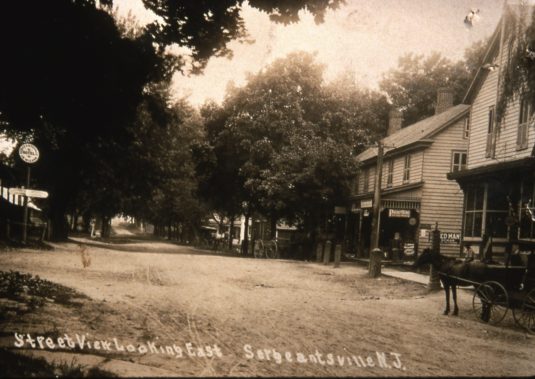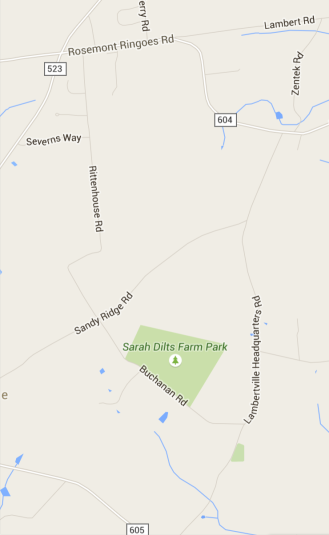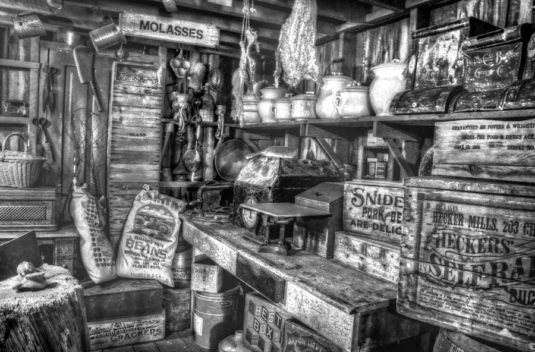 While working on a history of the Sergeantsville Inn, I realized that this would be a good time to publish Egbert T. Bush’s article about the places that made Sergeantsville such an interesting little town. Mr. Bush did not have the advantage of adding photographs the way I do. These pictures come from the postcard collection of Paul Kurzenberger. (Note that Mr. Bush’s article is in italics; my comments are not.)
While working on a history of the Sergeantsville Inn, I realized that this would be a good time to publish Egbert T. Bush’s article about the places that made Sergeantsville such an interesting little town. Mr. Bush did not have the advantage of adding photographs the way I do. These pictures come from the postcard collection of Paul Kurzenberger. (Note that Mr. Bush’s article is in italics; my comments are not.)
Sergeantsville
SERGEANTSVILLE is located in the heart of Delaware Township, and serves as its de facto capital. The tavern of former years is now the township municipal building. Except for Perth Amboy’s municipal building, Delaware Township’s is the longest continually used building for municipal government. Being located at the intersection of county routes 523 and 604, it is still a fairly busy place, but nothing like it was in the 19th century, when farmers would come to town to shop and collect their mail.
Sergeantsville Inn, part three
Sergeantsville Inn, Part 2
Part one of this story was published last year in March 2015 (The Sergeantsville Inn). It was written quickly, and covered the time period from the original proprietary deed to the end of the 19th century. Part Two goes back to 1830 to add more information to the story.
The ‘Wickcheoche’ Tribe of Red Men
Many years ago, Bob Dilts wrote an article entitled “Sergeantsville’s a Nicer Name.”1 While describing George Fisher’s harness shop (pictured below), on the southeast corner of the main intersection, Dilts wrote a paragraph that really caught my attention:
The Thatcher Burying Ground
There is a tiny burying ground located on a plot of land across from the Delaware Township Municipal Building that is used during the summer by the Sergeantsville Farmers’ Market. It is hidden in a clump of trees, and very few people know of its existence.
A Pirate in Old Amwell
When writing about Pine Hill Cemetery recently, the name of John Lewis came up. This reminded me of a wonderful article written by Jonathan M. Hoppock back in 1905 about a mysterious character named Ticnor Lewis who lived not far from Pine Hill. It is one of Mr. Hoppock’s most colorful yarns, and one of his many stories of the early settlers in Amwell Township. This one is based entirely on folklore or family tradition. A bowl-full of salt is highly recommended.
Pine Hill Cemetery, Revisited
Pine Hill Cemetery is one of the most interesting of the old family burial grounds in Hunterdon County. I have written about it before, in an article that listed the known graves with some biographical information. But I had just scratched the surface; there is so much more to be said.
Rittenhouse Road

There is an odd sort of road in Delaware Township, running south from Sergeantsville, that I have often wondered about. It is called Rittenhouse Road, and for much of its length, it runs straight as an arrow, then suddenly does a zigzag before ending at Sandy Ridge Road.
Quite often the very straight roads in Hunterdon County were created as a result of the early, large proprietary tracts that forced roads to run along their borders. But that is not the case here. This road ran through the middle of Daniel Robins’ 700+ acres, surveyed in 1722.
A Barn Raising Was A Big Event
Feeding Fifty Men Was Not Uncommon on Such an Occasion
Eatables in Great Abundance
by Egbert T. Bush, Stockton, N.J.
originally published by the Hunterdon Co. Democrat, July 24, 1930
Note: I have included the punctuation as it appeared in the original article, even though I disagree with the editor’s use of commas, and wonder if that was how Mr. Bush wrote it. Also, when Mr. Bush refers to “the young generation,” he means people born in the late-19th and early 20th-century. Mr. Bush was born in 1848.
The Sergeantsville Inn
The original version of this post, published on March 14, 2015, has been significantly revised because of new information I have received. Most of these revisions concern Jonas Thatcher, Jr. Consider this Chapter One of the History of the Sergeantsville Inn.
